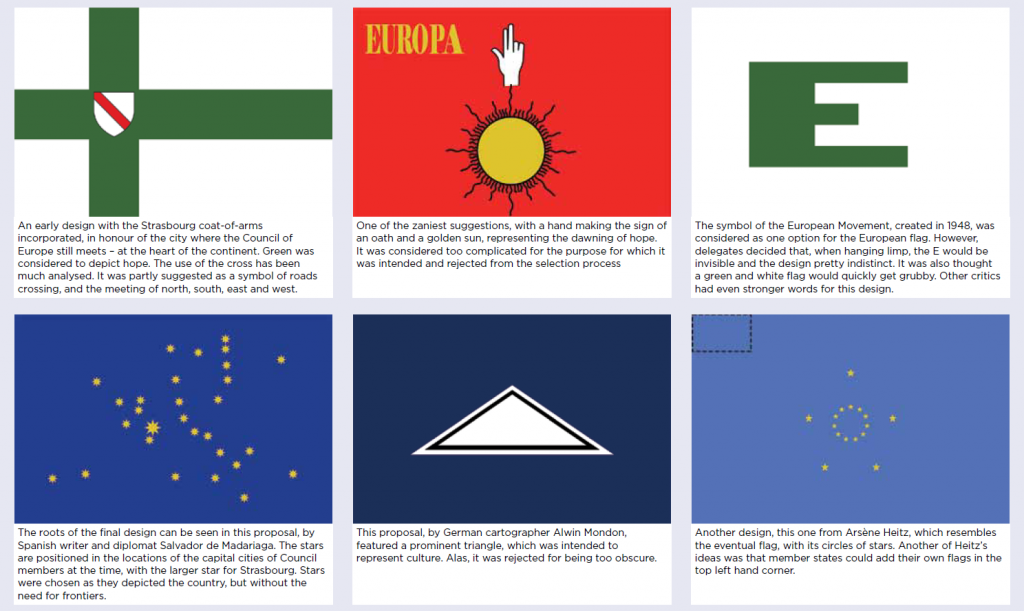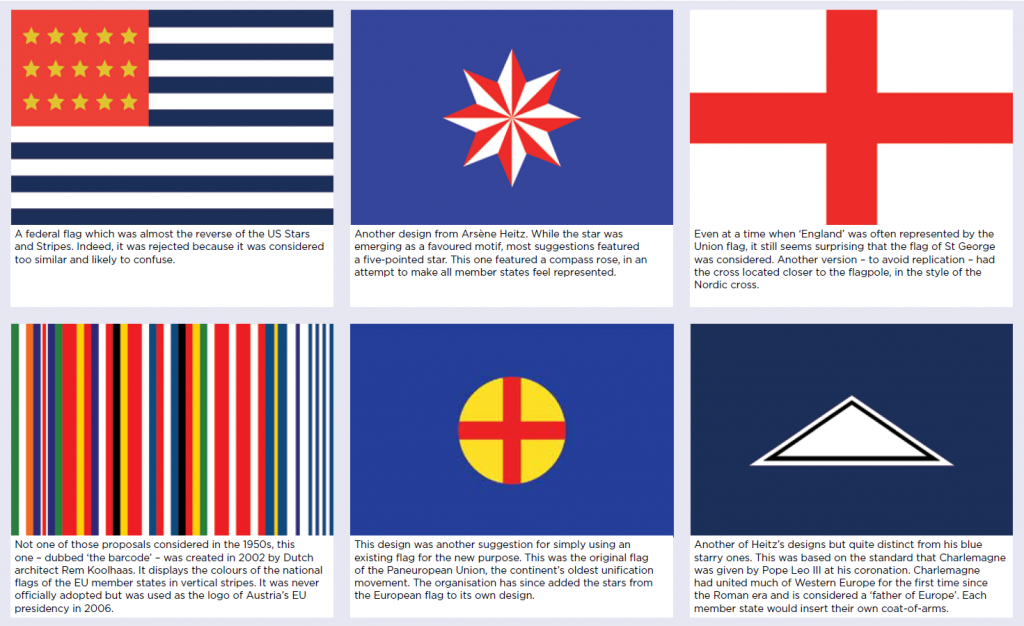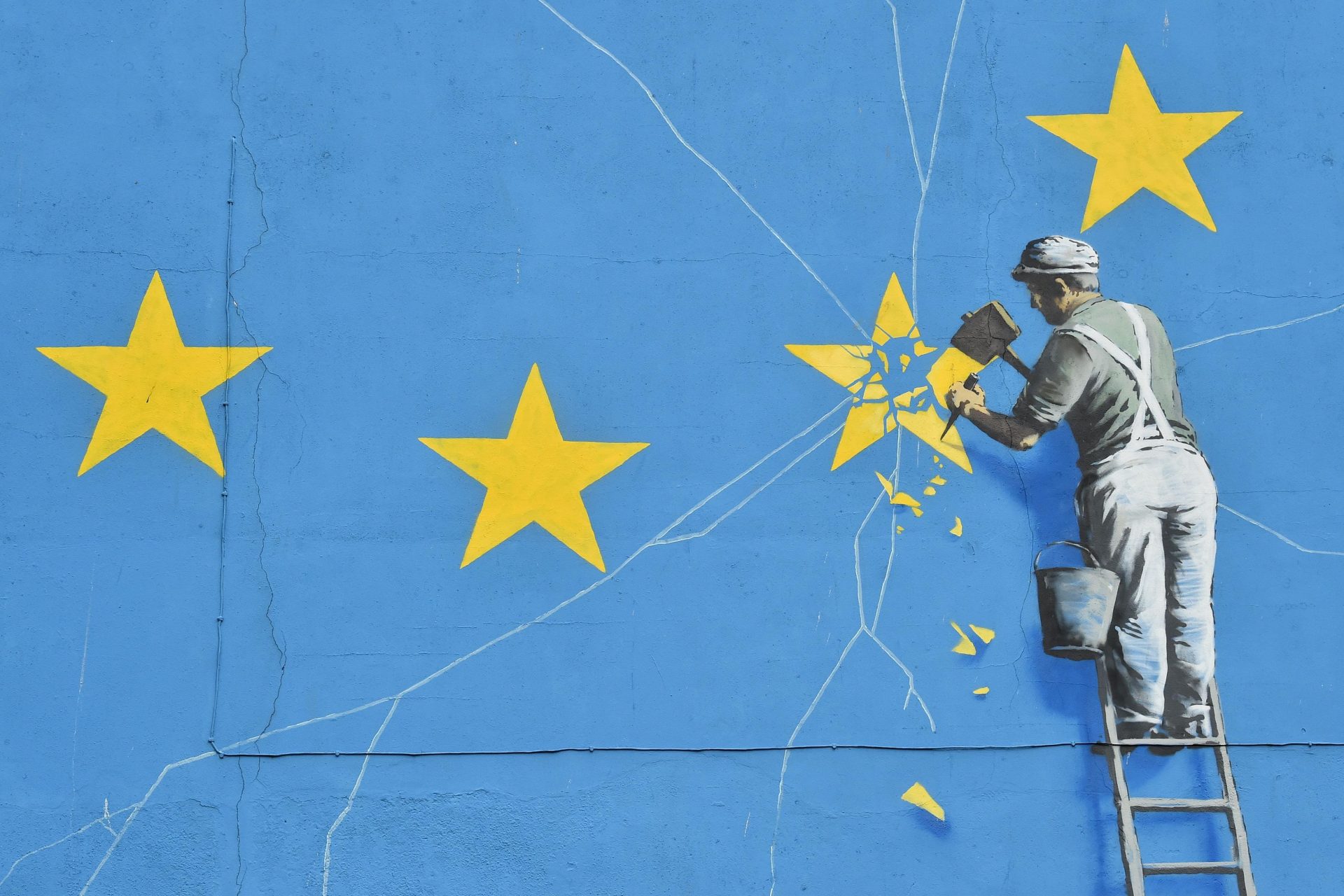The mural was striking: a worker chiselling out one of the stars on the European Union flag after the Brexit referendum. But while we understood and – readers of this newspaper almost unanimously – sympathised with the sentiment, Banksy got it wrong.
The stars on the flag do not represent the nations of the EU, despite the common perception that they do. Quite obviously there were once 28 nations, while the flag only has 12 stars.
So what, if anything, is represented by the familiar gold stars on a blue background – whose official blazon (or heraldic description) is “on an azure field a circle of 12 golden mullets, their points not touching”? And how did said mullets and circle end up as the official emblem of the EU?
Firstly, its correct title is the ‘Flag of Europe’ because it can be used by institutions other than the EU. Its adoption by the Council of Europe, formed in the post Second World War era, in 1955 preceded its ratification by the European Community (EC), the forerunner to the EU, by 30 years.
And officially it can be used by pan-European organisations elsewhere, including sports teams such as Europe’s Ryder Cup golfers. At the time of its acceptance by the EC, the UK argued that adopting the flag conferred some sort of statehood to the organisation so although official EC wording described it as a ‘logo’ or ‘emblem’ this has always been pretty much disregarded, more so following Brexit.
It certainly went through a lengthy gestation. The council appointed a committee in 1950 to look into proposals made by Paul Lévy for adopting a symbol to represent all of post-war Europe. Belgian-born Lévy, a journalist before the war, was the council’s director of information and, significantly, a Holocaust survivor who had reported the liberation of the Dachau concentration camp. He had much personal investment in creating a symbol of a new Europe at peace with itself.
And while the incumbent flag is instantly recognisable it’s perhaps illuminating to discover what was rejected. Many early designs included crosses. Lévy, of Jewish descent but a convert to Catholicism, believed a cross represented the stability of Europe but also marked a crossing point and four compass directions. But ultimately crosses were rejected because they were considered to exclude non-Christians. Ironically, in the light of what has subsequently happened – one of those rejected was the cross of St George proposed by Count Richard Coudenhove-Kalergi.

Europe’s oldest unification organisation, the Paneuropean Movement, had been founded in 1923 by Coudenhove-Kalergi, a polymath of Austro-Japanese descent who was first a Czech then a French national. Its flag of a blue background, with a yellow circle containing a red cross was also rejected on similar lines – adding a crescent did not allay Turkey’s disapproval. However, the flag’s colours would later influence the final successful design.
Many early efforts incorporated the coat of arms of Strasbourg, home to the Council of Europe, but again these were declined as the council felt no single nation or city should be represented.
The star of liberation used by the victorious Allied armies towards the end of the Second World War was also considered as was the striking design of a green E on a white background.
This was the symbol of the European Movement, created in 1948 with the goal of promoting European integration following wartime devastation, but delegates decided that, when hanging limp, the E would become pretty much invisible.
Harsher critics cited it as “a crime against graphic design”.
Some designs were especially esoteric. Cartoonist Alwin Mondon’s designs, all depicting a triangle – apparently a symbol of culture – were rejected for being too obscure; Erich Müller’s red flag with gold “EUROPA” lettering and a white hand making the sign of the oath was considered too complicated while Robert Poucher’s reversed US-style stars and stripes was rejected for the more obvious reason of being likely to confuse.
The field was so crowded the council began restricting entries. None should provoke national or religious rivalries (crosses finally barred); elegance, beauty and dignity were encouraged (no big Es) and preferred colours were proposed – any colour that appeared in a European nation’s flag was accepted but green and white, the colours of the European Movement, and sky blue, symbolising peace and neutrality, were recommended.
In 1954 and 1955 after many earlier submissions Arsène Heitz’s designs, based on one of those suggested by the Council of Europe’s members themselves, began to coalesce around a blue flag with stars in some configuration, especially after council members decided a green and white flag would get dirty too easily.
Fifteen stars, the number of council nations at that time, was rejected by West Germany who objected to the Saar protectorate (partitioned from Germany after the war and administered by France) having its own star and hence implied sovereignty.
By September 1955, Heitz’s latest design (although this was later disputed by Lévy) depicting 12 gold stars surrounding a central star looked remarkably like the current flag and possibly drew inspiration from an earlier entry by Spanish writer and diplomat Salvador de Madariaga.
The latter’s design was in similar colours with a star representing each European nation in their geographical positions. Heitz’s central star was intended to represent Strasbourg with the others aligning around it. Three months later the council dropped its insistence on sky blue, lost the central star of Heitz’s design, and the flag we recognise today became official.
The council formally described it as: “Against the blue sky of the Western world, the stars symbolise the peoples of Europe in a form of a circle, a sign of union. Their number is invariably 12, the figure 12 being the symbol of perfection and entirety.” The EC later used similar wording but omitted “Western world”.
So far so prosaic, which is perhaps why other interpretations of the flag from disparate organisations and individuals prefer deeper, more introspective interpretations.
Vexillologists, those who study flags, posit that five-pointed stars are representations of aspiration and education, their golden colour symbolising glory and enlightenment. Their arrangement on the flag represents the Corona Borealis constellation, their crown-like configuration noting stability. There’s more, if such iconography is your thing: blue resembles the sky, truth and intellect.

Others see embedded religion. Twelve is the number of Christ’s apostles, the number of sons of Jacob and the number of labours performed by Hercules. Blue is the colour that traditionally represents Mary, mother of Christ and in many paintings she is crowned with 12 stars. Of course, this can only be inferred, but in 1987 Heitz, a Catholic, rather late in the day gave weight to the suppositions by claiming he introduced so-called “Marian iconography” into his design after seeing a statue of Mary.
Other, more secular, critics have argued this all seems most unlikely considering the disparate peoples and belief systems Europe encompasses.
Arguments such as this are simplistic, they say. Confirmation bias is likely at work. There are many other ‘12s’ to choose if you are so inclined: the zodiac has 12 signs, there are 12 hours on a clock face or 12 months in a year.
For his part Lévy said he and his colleagues were unaware of any religious connotations – surely the intent of the council who had already rejected crosses. Lévy also added a further note of controversy by suggesting the flag design wasn’t wholly Heitz’s, claiming he had to grapple with Heitz’s multiple submissions to distil them down to the final eloquent version, the exact design of which was his.
The endless disputes rather give credence to the notion that vexillology, as one wag posited, is actually the study of irritation and controversy.
And there’s little doubt the EU flag vexed and irritated some Brexiters – it was once Brexit Party policy to ban it being flown in the UK.
As another wag never paraphrased: you start by banning the flag and end up banning the people. But for others, flags illuminate and unite; symbols of hope and diversity rather than vexatious nationalism.
As one of the few non-national flags recognisable worldwide, the flag of Europe has benign intent, whatever some in the UK might proclaim.
Ironically it has even been used by opposition movements in countries such as Georgia and Belarus as a symbol of protest against oppressive regimes.
It might have had a long and tortuous incubation, but it turned out rather tasteful in the end.
FLAG FACTS
The flag was first flown on December 13, 1955, at the Chateau de la Muette in Paris and now appears on any number of random items including driving licences, food labels and car number plates.
The colours used in the flag are agreed on and regulated by the Council of Europe and the European Union as Pantone Reflex Blue and Pantone Yellow.
The flags of Kosovo and Bosnia & Herzegovina are, in part, based on the design of the flag of Europe as is the flag of the Brussels Capital Region.
A replacement flag, designed by Dutch architect Rem Koolhaas in 2002, carried the colours of every EU nation in vertical stripes. Whether it was ever seriously considered as a replacement is a matter of conjecture but after being ridiculed as looking like either a barcode or a deckchair it had little chance of being formally adopted.
Warning: Illegal string offset 'link_id' in /mnt/storage/stage/www/wp-includes/bookmark.php on line 357
Notice: Trying to get property 'link_id' of non-object in /mnt/storage/stage/www/wp-includes/bookmark.php on line 37







